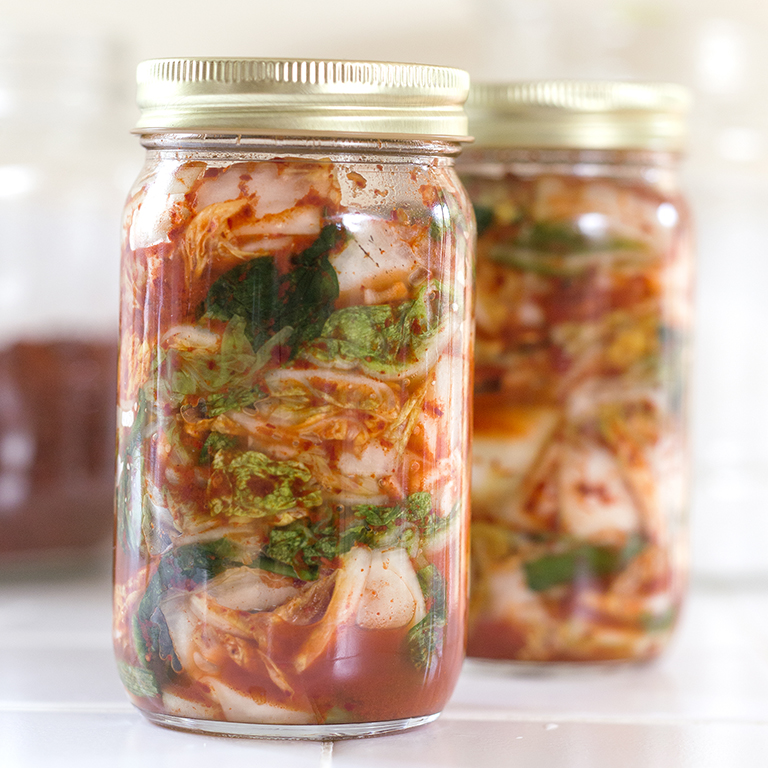
Photo: Thomas J. Story
This fiery kimchi closely resembles the award-winning product that Chong Choi and her son Matt Choi sell at the Portland State University Farmer’s Market stand and at grocery stores throughout the Pacific Northwest. Although Chong warns that only gochugaru (ground Korean chiles) will produce an authentic flavor, you can make a delicious kimchi with a combination of dried mild New Mexico chiles and hotter Thai or arbol chiles.

Photo: Thomas J. Story
Quarter cabbage lengthwise. Cut out and discard core at base of each quarter, then slice cabbage crosswise into 2 1/2-in. pieces. Put cabbage in a large bowl, cover with water, and let sit for a minute.
Drain cabbage and return to bowl. Add the daikon radish, sprinkle with salt, and toss with your hands to coat thoroughly.
Press down on vegetables to compact them; let sit at room temperature for 20 minutes. Stir to redistribute the salt and let vegetables sit uncovered at room temperature, 5 to 6 hours (no need to stir again).
Put vegetables in a large bowl of cold water and swish to rinse, then drain and repeat until it is as salty as you like. “I change the water up to three times, tasting as I go to gauge saltiness. The thickest part of the cabbage won’t taste salty and will have crunch, but the leafy part will be wilted and you’ll taste a little salt.”
After the final draining, gently squeeze out most of the liquid and transfer vegetables to a large, clean, dry bowl. Peel, halve, and core the Asian pear. “The pear adds natural sweetness and is refreshing to the palate.” Cut into 1/4-in.-thick slices, then into 1-in.-wide pieces (you should have about 3/4 cup). Add pear to bowl with all remaining ingredients except the green onion. Mix thoroughly, then gently mix in the green onion.
Pack kimchi into two clean 1-pt. jars, leaving 1 1/2 in. of headspace below the rim. Push vegetables down firmly into the jars so the liquid within the jars rises.
Seal jars with a tight-fitting lid and let sit on a rimmed baking sheet at room temperature, away from direct sunlight. Fermentation time varies, but at warm room temperature, it should take 2 to 3 days; if it’s cool, up to 1 week. Sample the kimchi regularly (it may fizz a little when you open the jar, a sign that the fermentation is working). Open jars over the sink in case they drip. “As the kimchi ferments, more liquid will come out of the vegetables. Check the jars every day and push down on the kimchi to cause the juices to come up. This ferments the topmost part of the jar.” When the kimchi is nicely tangy, it’s ready to eat. It will keep, refrigerated, for up to 3 months.
* Gochugaru, coarsely ground sun-dried red Korean chiles, has a fruity, smoky flavor. (It’s not to be confused with the Korean chile paste called gochujang.) Find it at Asian markets and online, and store in the freezer to keep it fresh. To make a good substitute for gochugaru, using a spice grinder or clean coffee grinder, coarsely grind 8 seeded dried New Mexico chiles with 5 or 6 seeded dried arbol or Thai chiles. Add more hot chiles to make it spicier if you like.
Makes about 2 pints (serving size: 1/4 cup)
0 servings
1
* The % Daily Value (DV) tells you how much a nutrient in a serving of food contributes to a daily diet. 2,000 calories a day is used for general nutrition advice.